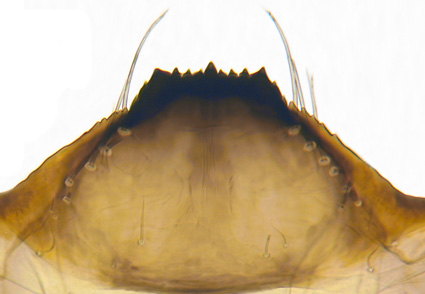Abstract
The polytene chromosomes, larva, pupa, and male are described for the black fly Simulium chaouikaidi n. sp., a member of the Simulium venustum group from Morocco. Chromosomally, this new species is one fixed inversion removed from the standard banding sequence for the subgenus Simulium and has microscopically undifferentiated sex chromosomes and minimal autosomal polymorphism. It is homosequential with two other species in the S. venustum species group: S. bergi Rubtsov and S. paramorsitans Rubtsov. Structurally, each known life stage of the new species is distinct from that of all other simuliids in North Africa. This new species is the southernmost member of the S. venustum group in the Old World and is apparently endemic to the Rif Mountains. Its restricted distribution includes Bou Hachem Natural Park where its habitat is afforded some protection.
References
- Adler, P.H. (2022) World blackflies (Diptera: Simuliidae): a comprehensive revision of the taxonomic and geographical inventory [2022]. 145 pp. Available from: http://biomia.sites.clemson.edu/pdfs/blackflyinventory.pdf (accessed 12 November 2023)
- Adler, P.H. (2023) Family Simuliidae. In: Maasri, A. & Thorp, J.H. (Eds.), Identification and Ecology of Freshwater Arthropods in the Mediterranean Basin. Elsevier, Amsterdam, pp. 603–639.
- Adler, P.H. & Crosskey, R.W. (2015) Cytotaxonomy of the Simuliidae (Diptera): a systematic and bibliographic conspectus. Zootaxa, 3975 (1), 1–139. https://doi.org/10.11646/zootaxa.3975.1.1
- Adler, P.H., Malmqvist, B. & Zhang, Y. (1999) Black flies (Diptera: Simuliidae) of northern Sweden: taxonomy, chromosomes, and bionomics. Entomologica Scandinavica, 29, 361–382. https://doi.org/10.1163/187631298X00014
- Adler, P.H., Currie, D.C. & Wood, D.M. (2004) The Black Flies (Simuliidae) of North America. Cornell University Press, Ithaca, New York, xv + 941 pp., 24 color plates.
- Adler, P.H., Kúdelová, T., Kúdela, M., Seitz, G. & Ignjatović-Ćupina, A. (2016a) Cryptic biodiversity and the origins of pest status revealed in the macrogenome of Simulium colombaschense (Diptera: Simuliidae), history’s most destructive black fly. PLoS ONE, 11(1), e0147673. https://doi.org/10.1371/journal.pone.0147673
- Adler, P.H., Yildirim, A., Onder, Z., Tasci, G.T., Duzlu, O., Arslan, M.O., Ciloglu, A., Sari, B., Parmaksizoglu, N. & Inci, A. (2016b) Rearrangement hotspots in the sex chromosome of the Palearctic black fly Simulium bergi (Diptera: Simuliidae). Comparative Cytogenetics, 10, 295–310. https://doi.org/10.3897/CompCytogen.v10i2.8855
- Belhaj, A., Pallarés, S., Bennas, N., Chergui, B. & Sánchez-Fernández, D. (2023) Towards the identification of hotspots of freshwater biodiversity in North-Western Africa: A case study using species distribution models for water beetles in Morocco. Global Ecology and Conservation, 43, e02441. https://doi.org/10.1016/j.gecco.2023.e02441
- Belqat, B. (2002) Etude systematique, ecologique et caryologique des simulies (Diptera: Simuliidae) du Maroc: cas particulier du Rif. Ph.D. Thesis, Université Abdelmalek Essaâdi. Tetouan, 322 pp., appendices.
- Belqat, B. & Dakki, M. (2004) Clés analytiques des simulies (Diptera) du Maroc. Zoologica Baetica, 15, 77–137.
- Belqat, B., Adler, P. & Dakki, M. (2001) Distribution summary of the Simuliidae of Morocco with new data for the Rif Mountains. British Simuliid Group Bulletin, 17, 10–16.
- Belqat, B., Dakki, M. & Alami, M. El (2005) Estructura biotipológica de las principales redes hídricas rifeñas a través de los simúlidos (Diptera: Simuliidae). Ecosistemas, 14, 50–56. [https://www.revistaecosistemas.net/index.php/ecosistemas/article/view/144]
- Belqat, B., Adler, P.H. & Crosskey, R.W. (2011) Faunistic and bibliographical inventory of the blackflies (Diptera: Simuliidae) of Morocco. Zootaxa, 2829 (1), 46–58. https://doi.org/10.11646/zootaxa.2829.1.2
- Belqat, B., Adler, P.H., Cherairia, M. & Boudghane-Bendiouis, C. (2018) Inventory of the black flies (Diptera: Simuliidae) of North Africa. Zootaxa, 4442 (2), 201–220. https://doi.org/10.11646/zootaxa.4442.2.1
- Benamar, L., Bennas, N., Hassoun, M. & Millán, A. (2021) Threatened endemic water beetles from Morocco. Journal of Insect Conservation, 25 (3), 465–477. https://doi.org/10.1007/s10841-021-00314-x
- Chance, M.M. (1970) The functional morphology of the mouthparts of blackfly larvae (Diptera: Simuliidae). Quaestiones Entomologicae, 6, 254–284.
- Ciadamidaro, S., Maiolini, B. & Ignjatovic-Cupina, A. (2013) An interview with Leo Rivosecchi. British Simuliid Group Bulletin, 40, 4–12.
- Craig, D.A. & Craig, R.E.G. (1986) Simuliidae (Diptera: Culicomorpha) of Rarotonga, Cook Islands, South Pacific. New Zealand Journal of Zoology, 13, 357–366. https://doi.org/10.1080/03014223.1986.10422669
- Dakki, M., Menioui, M. & Zouhair, A. (2015) Stratégie Nationale et plan d’action 2015–2024 pour les Zones Humides du Maroc. Deutsche Gesellschaft für Internationale Zusammenarbeit (GIZ) GmbH, Rabat, 56 pp. [https://medwet.org/wp-content/uploads/2017/03/strategie-nationale_-ZH_Maroc.pdf]
- El Alami, M., El Yaagoubi, S., Gattolliat, J.-L., Sartori, M. & Dakki, M. (2022) Diversity and distribution of mayflies from Morocco (Ephemeroptera, Insecta). Diversity, 14, 498. https://doi.org/10.3390/d14060498
- Errochdi, S., El Alami, M., Vinçon, G., Abdaoui, A. & Ghamizi, M. (2014) Contribution to the knowledge of Moroccan and Maghrebin stoneflies (Plecoptera). Zootaxa, 3838 (1), 46–76. https://doi.org/10.11646/zootaxa.3838.1.2
- Fader, M., S. Shi, von Bloh, W., Bondeau, A. & Cramer, W. (2016) Mediterranean irrigation under climate change: more efficient irrigation needed to compensate for increases in irrigation water requirements. Hydrology and Earth System Sciences, 20, 953–973. https://doi.org/10.5194/hess-20-953-2016
- Huang, Y.T., Adler, P.H. & Takaoka, H. (2011) Polytene chromosomes of Simulium arakawae, a pest species in the Simulium venustum species group (Diptera: Simuliidae) from Japan. Tropical Biomedicine, 28, 376–381. [https://drive.google.com/file/d/0B75lcx0mfp2OMHNQQktDQ281NXM/view?pli=1&resourcekey=0-ij0F-w6zntR6EWtayG3hBw]
- Ibrahimi, H., Mabrouki, Y. & Taybi, A.F. (2021) Tinodes atlasensis Ibrahimi, Mabrouki & Taybi, sp. nov. (Trichoptera: Psychomyiidae), a new species from Atlas Mountains, Morocco. Natura Croatica, 30, 367–375. https://doi.org/10.20302/NC.2021.30.23
- Moore, H.M., Fox, H.R., Harrouni, M.C. & El Alami, A. (1998) Environmental challenges in the Rif mountains, northern Morocco. Environmental Conservation, 25, 354–365. https://doi.org/10.1017/S0376892998000435
- Rivosecchi, L. (1978) Simuliidae: Diptera Nematocera. Fauna d’Italia, 13, 1–533. [in Italian]
- Rothfels, K., Feraday, R. & Kaneps, A. (1978) A cytological description of sibling species of Simulium venustum and S. verecundum with standard maps for the subgenus Simulium Davies (Diptera). Canadian Journal of Zoology, 56, 1110–1128. https://doi.org/10.1139/z78-155
- Ruiz-Arrondo, I., Veiga, J. Adler, P.H., Collantes, F., Oteo, J.A. & Valera, F. (2023) Integrated taxonomy of black flies (Diptera: Simuliidae) reveals unexpected diversity in the most arid ecosystem of Europe. PLoS ONE, 18 (11), e0293547. https://doi.org/10.1371/journal.pone.0293547
- Sala, O.E., Chapin, F.S., Armesto, J.J., Berlow, E., Bloomfield, J., Dirzo, R., Huber-Sanwald, E., Huenneke, L.F., Jackson, R.B., Kinzig, A., Leemans, R., Lodge, D.M., Mooney, H.A., Oesterheld, M., Poff, N.L., Sykes, M.T., Walker, B.H., Walker, M. & Wall, D.H. (2000) Global biodiversity scenarios for the year 2100. Science, 287, 1770–1774. https://doi.org/10.1126/science.287.5459.1770


